Intel Core i7 3960X (Sandy Bridge E) Review: Keeping the High End Alive
by Anand Lal Shimpi on November 14, 2011 3:01 AM EST- Posted in
- CPUs
- Intel
- Core i7
- Sandy Bridge
- Sandy Bridge E
Gaming Performance
Most games have a tough enough time stressing more than four cores, so the move to the 3960X won't do much for gaming in most cases (particularly when GPU bound). That being said, the added cache may help give SNB-E a slight bump over its quad-core brethren.
Civilization V
Civ V's lateGameView benchmark presents us with two separate scores: average frame rate for the entire test as well as a no-render score that only looks at CPU performance.

In GPU bound scenarios the 3960X is no different than the 2600K. Civ V is a unique game in that its CPU workload does scale reasonable well across multiple cores:
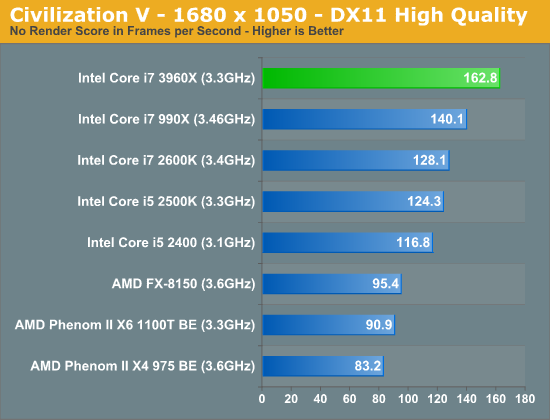
Here the 3960X is nearly 30% faster than the 2600K.
Crysis: Warhead
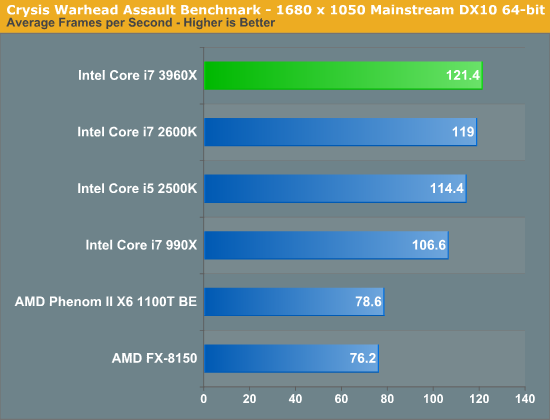
Dawn of War II
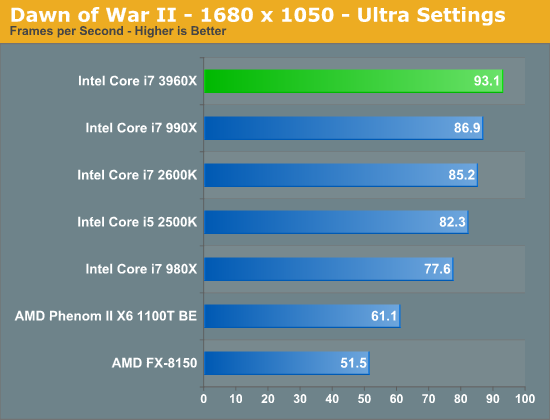
The larger cache helps give the 3960X a 9% advantage over the 2600K in Dawn of War II. At 1680 x 1050 the game isn't entirely GPU bound on our 5870.
DiRT 3
We ran two DiRT 3 benchmarks to get an idea for CPU bound and GPU bound performance. First the CPU bound settings:

DiRT 3 is an example of a CPU bound title (at lower resolutions) that doesn't scale well with core count or cache size. The 3960X is barely 2% faster than the 2600K.
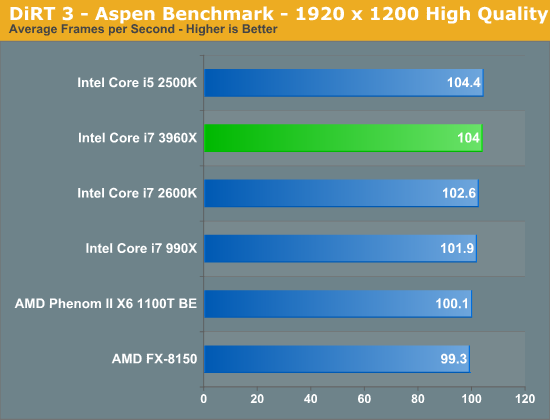
Metro 2033
It is interesting to note that while SNB-E and SNB perform similarly here, both parts do offer a performance improvement over the Gulftown based 990X.
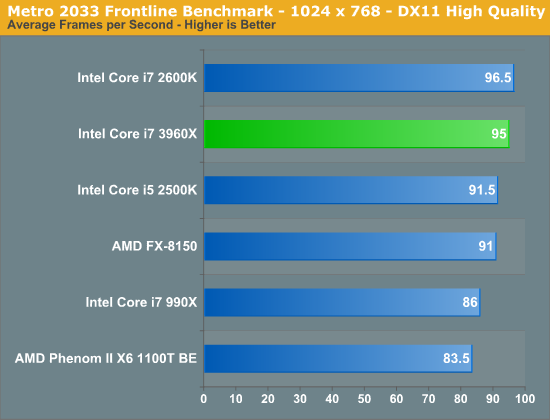
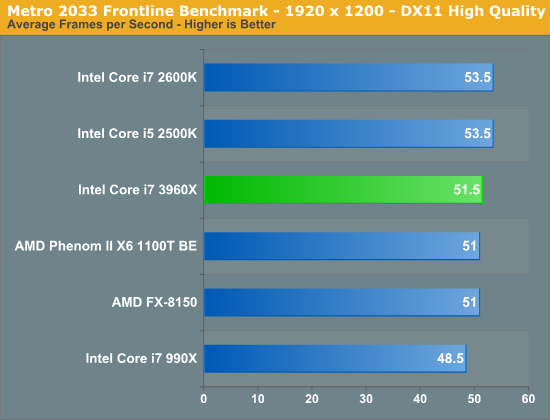
Rage vt_benchmark
While id's long awaited Rage title doesn't exactly have the best benchmarking abilities, there is one unique aspect of the game that we can test: Megatexture. Megatexture works by dynamically taking texture data from disk and constructing texture tiles for the engine to use (note that Rage doesn't store textures in a GPU-usable format). As a result whenever you load a texture, Rage is transcoding the texture on the fly. This is normally done by the CPU.
The Benchmark: vt_ are all the virtual texture commands. Vt_benchmark flushes the texture cache and then times how long it takes to transcode all the textures needed for the current scene, from 1 thread to X threads. Thus when you run vt_benchmark 8, for example, it will benchmark from 1 to 8 threads (the default appears to depend on the CPU you have). Since transcoding is done by the CPU this is a pure CPU benchmark. I present the best case transcode time at the maximum number of concurrent threads each CPU can handle:
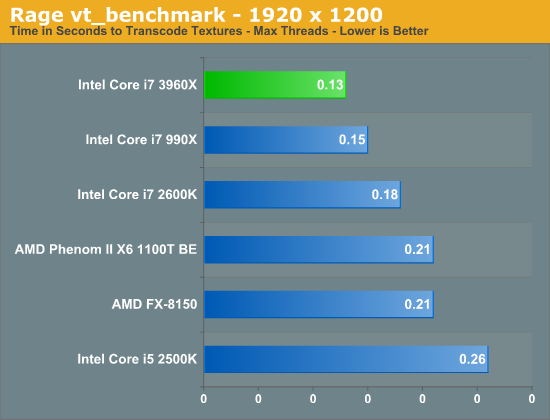
Starcraft 2
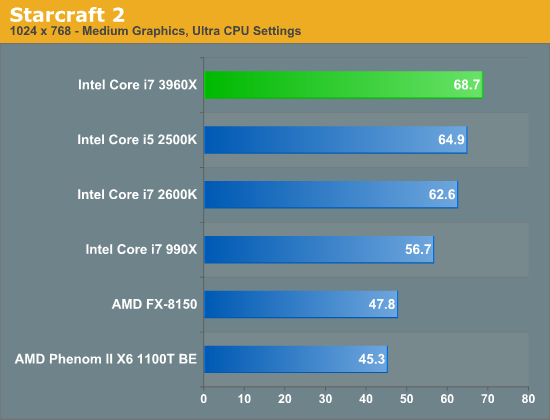
World of Warcraft
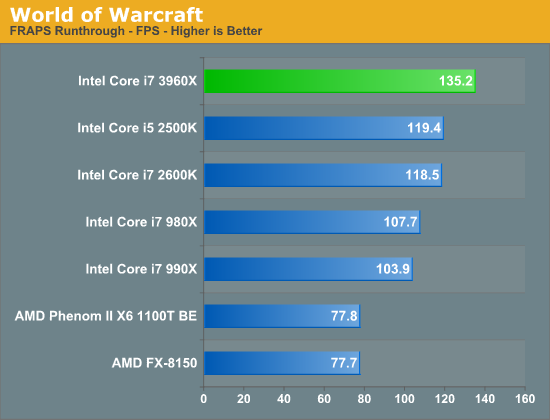
WoW does enjoy the 3960X's larger cache, here we see a 13% increase in performance compared to the regular Sandy Bridge parts.










163 Comments
View All Comments
yankeeDDL - Monday, November 14, 2011 - link
I'm with you xpclient.I will never understand Microsoft's fanboys. Why do they expect the OS to make such huge impact on the benchmarks?
It's like for motherboards: you can differentiate for ease of use, stability, features, supported hardware ... but the benchmarks, will substantially be the same.
XP trails Windows7 on multi core because it was never designed to support so many cores, and MS has no interest in updating it.
Per Hansson - Monday, November 14, 2011 - link
Hi, what resolution and in game graphical settings where used for the World of Warcraft gaming test?It always amazes me how well that game scales with super high-end CPU's, but if it's at just a silly low resolution it does not really matter, so, which is it? (This isn't mentioned in "bench" either....)
Per Hansson - Monday, November 21, 2011 - link
Here is Anand's reply to this question incase anyone cares ;)---
1680 x 1050, 4X AA, all detail settings maxed (except for weather) :)
Take care,
Anand
Mightytonka - Monday, November 14, 2011 - link
Typo on the second page. Should read RST (Rapid Storage Technology), right?Ocire - Monday, November 14, 2011 - link
Nice review! :-)If you want to test PCIe bandwidth, you could use the bandwidth-test that comes with the CUDA SDK. It's easy to setup, and you can also test configurations with multiple GPUs. You should get quite reliable results for pure PCIe Gen.2 performance with that.
It would be really interesting to get some performance numbers for PCIe as that is the bottleneck in quite a few GPU-computing scenarios.
Cheers!
LancerVI - Monday, November 14, 2011 - link
Sounds like a great, enthusiast proc, married to a mainstream chipset at enthusiast prices.That means 'no joy' for me.
I guess I'll be hanging on to my little i7 920 that could for a bit longer. Going on 4 years now. That's unheard of for me!!!
hechacker1 - Monday, November 14, 2011 - link
I'm also going to hang onto the i7 920. Overclocked the x58 platform can still compete with the best of of Sandy Bridge for almost any workload. Sure we're missing some IPC and power enhancements, but nothing worth spending serious cash on.What I'm looking at now is the Gulftown prices. I'm hoping they come down from the $1000 Extreme part, and perhaps we get an affordable 6-core chip for the X58 platform.
I'd be happy to stick with Gulftown until we see affordable 8 core parts, or major IPC improvements.
Makaveli - Monday, November 14, 2011 - link
the 980 non X version is already going for $550This is your next upgrade, as is mine i'm also on a 920.
I doubt that price will drop any lower.
hechacker1 - Monday, November 14, 2011 - link
Yeah I'm going to be watching the prices closely for a while.At $550 for the lowest end Gulftown on newegg, it's still not affordable for me.
It's still cheaper than the intro prices of Sandy Bridge-E including a new motherboard though.
I'll have to watch forums closely for people wanting to sell their chips, I imagine you can snag one used for a good deal.
davideden - Monday, November 14, 2011 - link
I currently have a Core i7 2600K LGA 1155 processor. I am assuming that I won't be able to use this with the new LGA 2011 socket on the new Sandy Bridge E motherboards. Will there be any cheaper processors in the near future that are at the price point of the Core i7 2600K that are compatible? I was disappointed with not being able to utilize triple channel with my memory or being able to use all my sticks of ram with the current LGA 1155 motherboards. The quad channel ram along with the 8 slots have me most excited for the new platform as I do video editing/motion graphics/3D work. Thanks!